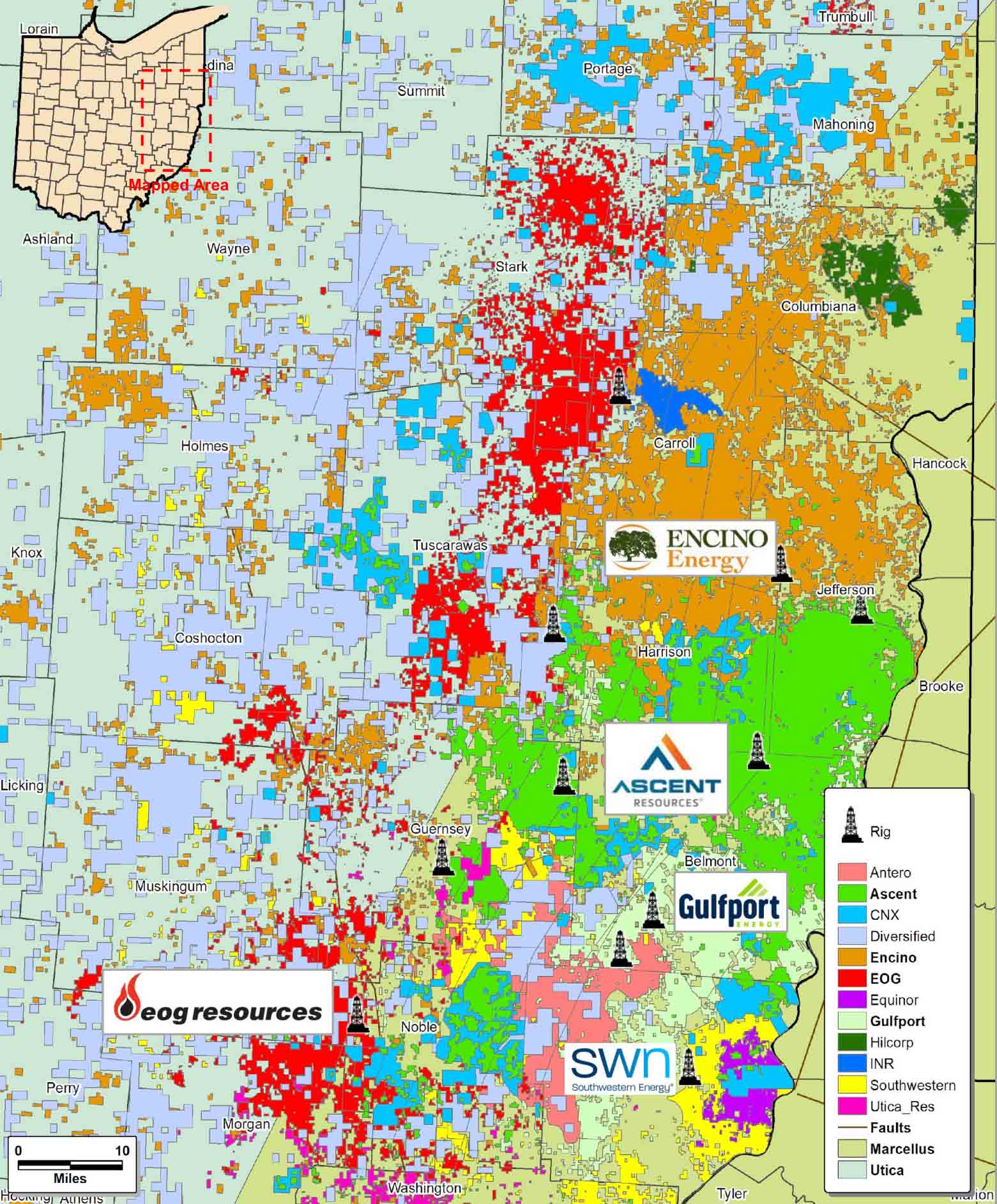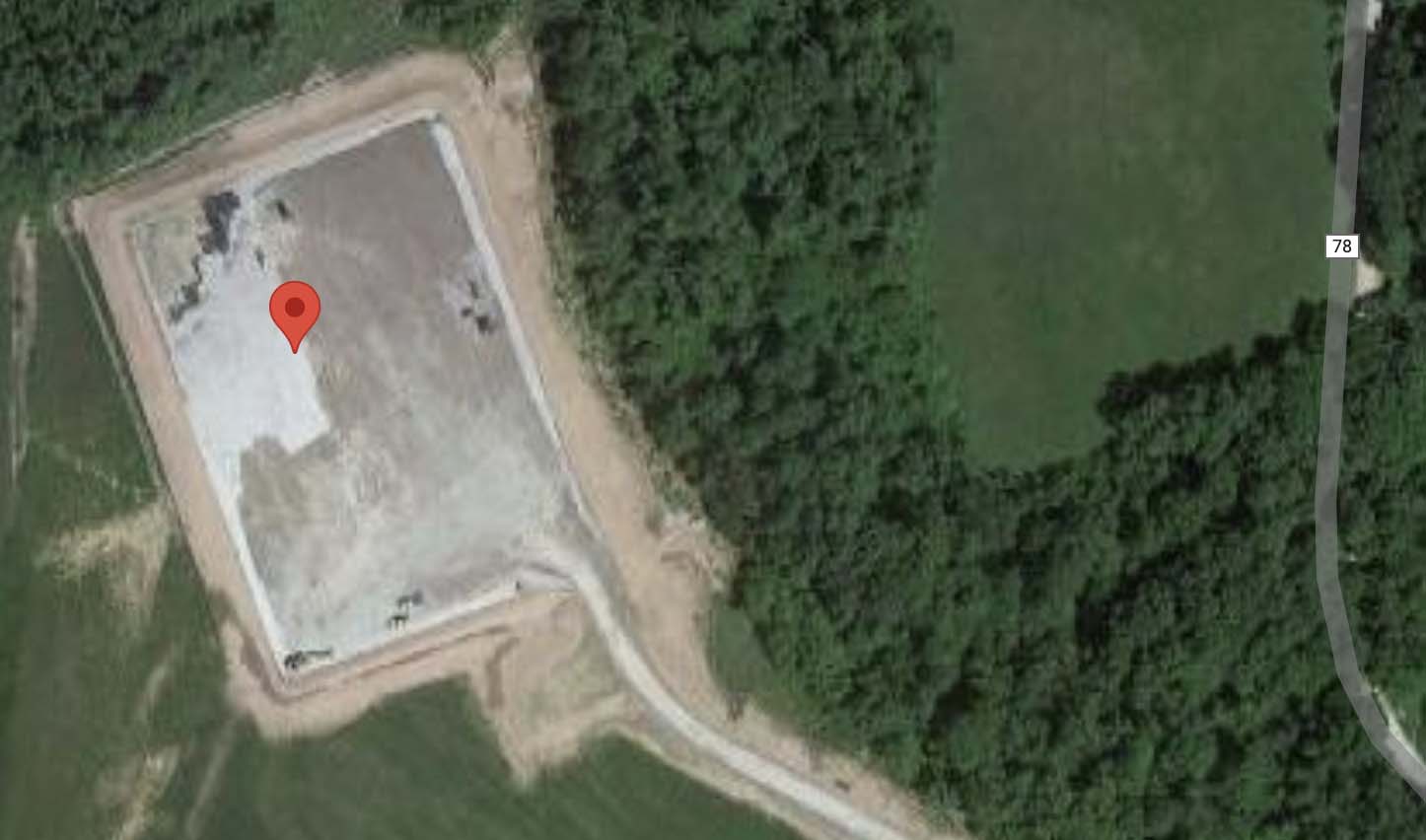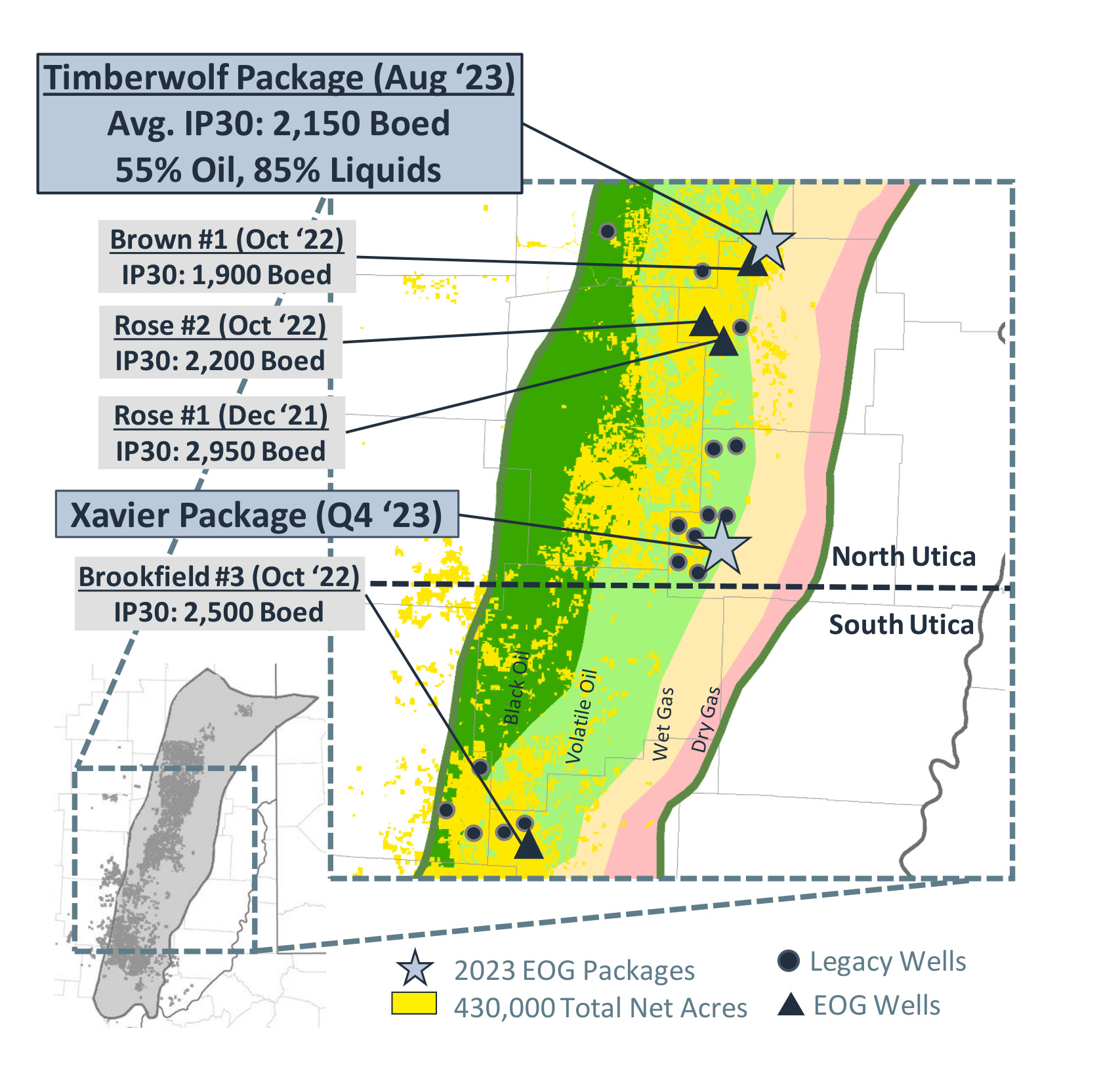More details have emerged about EOG Resources’ newest Ohio four-well test pad, Timberwolf CBN16, which churned out 180,000 bbl of oil in its first 37 days online, along with 580 MMcf of gas and NGL.
EOG's re-entry to Ohio exploration after a false start in the 2010s has reignited interest in oil-window opportunities in the state's Utica Shale, which has successfully produced from its gas-weighted phase.
In the three-section unit, one of the wells, Timberwolf #8A, made 50,341 bbl during the timespan for an average of 1,360 bbl/d, according to state and other data. Located in Carroll County, it also surfaced 161 MMcf of solution gas, or about 4.4 MMcf/d.
East of Malvern, Ohio, the pad began production this past summer from the Point Pleasant limestone/shale formation underlying the Utica at about 7,000 ft. The pad’s first 37-day average was 4,855 bbl/d; the per-well average was 1,214 bbl/d.
Timberwolf is along the eastern edge of the volatile-oil fairway at its intersection with the wet-gas phase. Results from another new pad—Xavier in Harrison County with seven wells permitted—are expected to be released by the state in March. Xavier also is at the volatile oil-wet gas intersection, along with other new EOG wells: Brookfield, Rose and Brown.
Ohio’s Department of Natural Resources (ODNR) places NGLs in the gas-stream column in its data. “The oil column only shows oil,” said Gregg Miller, ODNR analyst. “All of the methane and wet gases are in the gas column. We do not have a breakout of the NGL components.”
EOG reported in November that the four-well Timberwolf pad’s mix was 55% oil, 30% NGL and 15% gas.
Volatile oil’s gravity is more than 40 degrees API with gas/oil ratios of 2,000 scf/bbl to 3,300 scf/bbl. Condensate’s gravity is between 40° API and 60° API. Wet gas or rich gas contains more ethane and less methane. In each, the difference becomes apparent at the wellhead where temperature and pressure result in molecules separating from or “falling out of” the stream.
Delineating west—not yet
Billy Helms, EOG president, told Goldman Sachs energy conference attendees Jan. 4 the Timberwolf wells are “definitely in the volatile oil window. So the oil gravity is less than 50. I want to say it's 48 gravity oil.”
The four Timberwolf wells were on 1,000-ft spacing. The Xavier wells will be at 800 ft, according to EOG comments in its November earnings call.
Ezra Yacob, EOG chairman and CEO, acknowledged at a BofA Securities’ energy conference Nov. 14 that Timberwolf’s 1,000-ft spacing is “a little bit conservative for how tight that rock is.” But EOG is only testing its play for now. “We're still continuing to work on the delineation,” he said.
Costs haven’t been disclosed. “We're still in the early stages … in learning in this play. We've got a lot of room for operational efficiency gains,” Jeff Leitzell, EOG’s COO, said in the earnings call. But expectations are that the play will have a sub-$5 finding and development cost.
Also, EOG hasn’t drilled on the western side of its volatile oil fairway—where it approaches the black oil window—primarily because “we had good quality seismic data over on the east side of it when we were first starting out,” Leitzell said.
Once optimal well spacing is determined, “we'll be able to kind of step out more to the west, and … we do expect it to get oilier,” he added.
EOG has pulled 48 new-drill permits since January 2020, according to ODNR records. In addition to Xavier, upcoming pads are Shadow (seven wells) in Carroll County, and in Noble County, Sable (four wells) and White Rhino (four wells).
EOG will have one full-time rig at work on its acreage this year, it reported; in 2023, it had one rig drilling half-time.
The company has 430,000 acres in Ohio—more than 90% held by production (HBP)—and owns 130,000 minerals acres in a roughly 140-mile north-south trend. The leasehold and minerals were reportedly bought in 2022 from Encino Energy and Artex Energy Group for some $500 million, according to Craig Davis, senior technical advisor for M&A advisory firm Energy Advisors Group (EAG).
Update: Year-old EOG wells
Meanwhile, an EOG well in Noble County, Brookfield NBK15 #3A located east of Belle Valley, that came online in the fourth quarter of 2022 averaged 1,148 bbl/d its first 77 days, and produced 184,665 bbl in its first 350 days, according to the updated ODNR records.
The 350-day average was 528 bbl/d.
Third-quarter production in 2023 averaged 194 bbl/d. Solution gas averaged 2.8 MMcfe/d in its first 77 days. The 350-day total was 900 MMcfe.
Another EOG well, Rose 0816 #2H in Carroll County, produced 106,623 bbl in its first 335 days online for an average of 318 bbl/d through Sept. 30. Third-quarter output was 151 bbl/d. Northwest of Dellroy, the well made an average of 629 bbl/d during its first two months.
Meanwhile, the neighboring Rose 0801 #1H—about 300 ft south of the #2H—has relatively underperformed, producing 45,548 bbl its first 426 days for an average of 107 bbl/d. Third-quarter production was 68 bbl/d.
EOG’s Brown 2117 #1H in Carroll County, about a half-mile southwest of the Timberwolf pad, was put back online in the third quarter, producing 24,195 bbl in 37 days or an average of 654 bbl/d. It first went online in the fourth quarter of 2022, making 11,438 bbl in 18 days.

Ascent Resources: The biggest oil wells
Ascent Resources holds Ohio’s top 2023 oil-well production rank through the third quarter with its Lavada RCH GR #2H in Guernsey County, according to ODNR data.
The well, east of Lore City, came online in the fourth quarter of 2022 with 1,531 bbl/d from a 16,040-ft. lateral. It surfaced 366,092 bbl in its first 349 days online, along with 1.35 Bcf of solution gas. In the third quarter, it was making 572 bbl/d.
Its companion well, Lavada #4H, made 302,468 bbl in its first 349 days online.
Ascent held the top eight oil wells in 2023 quarterly rankings through the third quarter. Its newly minted six-well Jackalope WSG GR pad produced more than 500,000 bbl in the first three quarters of 2023 while online for only a combined 386 days, averaging 64 days each.
In Guernsey County, west of Londonderry, Jackalopes’ two longest-online wells—Jackalope South #4H and Jackalope Southeast #6H—made 116,582 bbl and 118,809 bbl, respectively, in the first quarter in their first 74 days. Jackalope #6H has a 15,075-ft lateral.
Meanwhile, Ascent is primarily focused on being Ohio’s top gas producer, making 919 Bcf in the four quarters ending June 30, 2023. EAP was No. 2 with 395 Bcf, followed closely by Gulfport Energy with 317 Bcf.
Ascent operates the second-most wells in Ohio with 849, while Gulfport, Antero Resources and Southwestern Energy hold some 900 combined, according to state data.
Backed by First Reserve and The Energy & Minerals Group, Ascent produces 2.2 Bcfe/d from its 357,000 net Ohio acres that include 80,000 mineral acres. It had four rigs running in the fourth quarter, according to EAG.
Its acreage was bought beginning in 2015 from Hess, Carrizo Oil & Gas, CNX Resources and others. Another purchase, for $270 million, is focused in Belmont County. The seller was Exxon Mobil.

Encino’s 3.5-milers
Coming in at No. 9 among top Ohio oil wells of 2023, Encino Energy’s EAP Ohio was crushing it in Harrison and Carroll counties.
Encino’s newest pad, Stocker, east of Dennison in Harrison County, produced 520,321 bbl from four wells in their first six months online, beginning in the second quarter.
The first 182-day average per well was 715 bbl/d, or 2,859 bbl/d for the entire four-well pad.
Operating the most wells in Ohio with 977 per state data, Encino also added four wells to its vintage 2020 one-well Williams CR MON pad in Carroll County. The new wells made 1.22 MMbbl their first 363 days online through the third quarter, or an average of 840 bbl/d per well. Solution gas totaled 6.3 Bcf.
Williams #5H has an 18,049-ft lateral, according to EAG. It came on with 127,688 bbl its first 92 days online. Williams #205H, with a 17,924-ft lateral, surfaced 124,257 bbl in its first 92 days.
Encino is Ohio’s top oil producer, making 12.7 MMbbl in the four quarters that ended June 30, according to ODNR data; Ascent was No. 2 with 6.9 MMbbl. In third place was Utica Resource with 1.5 MMbbl.
Tim Parker, Encino chief technical officer, said at Hart Energy’s DUG Appalachia conference in November that the Utica’s oilier fairway “has better margins” than the basin’s dry gas window. And it also “means that we aren't subject to bumping up against [basin pipeline] export capacity limits.
“So the oil play makes a great deal of sense for us,” Parker added. “Not only do we have the scale to do it, but the economics are really compelling.”
Encino has been shifting its drilling focus to growth in the liquids window, he said. “When you have economics of the magnitude that we do, we want more of it.”
Encino had three rigs running in the fourth quarter: one in the dry-gas window; one for volatile oil; and one for wet gas, according to EAG.
Formed in 2017 with backing from Canadian pension-fund manager CPPIB, Encino bought Chesapeake Energy’s Ohio property for $1.9 billion in 2018. The deal came with 938,000 net acres (1.4 million gross, 85% HBP), of which Chesapeake had called 320,000 “core acres,” according to EAG.
It included 642 MMcfe/d, primarily gas. Proved reserves were 2.9 Tcfe.

Utica Resource, INR, NOG
Also ranking in the Top 100 is Utica Resource Operating, first at No. 32 with a Guernsey County well, Stillion #9H, that surfaced 77,202 bbl in the second quarter. Utica Resource contributed nine wells to Ohio’s Top 100 of 2023’s first three quarters.
Meanwhile, Infinity Natural Resources took two positions, first at No. 87 with its Goebler #10H in Carroll County that produced 54,170 bbl in the first quarter.
Entering the 2023 ranking at No. 99 was EOG’s Brookfield #3A with first-quarter production of 50,694 bbl, followed by its Timberwolf #8A with 50,341 bbl in the third quarter at No. 100.
Non-operating producer Northern Oil & Gas is buying into the Utica/Point Pleasant’s gas-weighted fairway in Ohio’s Jefferson, Harrison, Belmont and Monroe counties. The percentage of interest, seller and purchase price were not disclosed.
The non-op interest is mostly in wells operated by Ascent, according to EAG.
The deal comes with some 23 MMcf/d net; a small amount of liquids; 0.8 net producing wells; and 1.7 net wells underway.
“We’ve always had a strong gas play, and we’ve continued to have a strong gas play,” Rob Brundrett, president, Ohio Oil & Gas Association, said at DUG Appalachia.
But the state’s oil production is rocketing. Between the first quarter of 2022 and the second-quarter of 2023, output increased 51%, he said.
In the second quarter of 2023, the state produced 6.9 MMbbl. That compares with second quarter 2022 production of 4.9 MMbbl, according to ODNR.
Recommended Reading
IGU: Global Liquefaction Capacity Expected to Grow by 75% by 2030
2024-07-02 - The International Gas Union (IGU) expects global liquefaction capacity to reach 700 mtpa by 2030, up 75% from 2023, driven by new FIDs and the start-up of other projects under construction.
Freeport LNG’s Slow Restart Stokes Concern Over Supply Risk
2024-07-23 - The 15-mtpa Freeport LNG facility remains under the spotlight of the global market as it slowly resumes operations after pausing ahead of Hurricane Beryl’s arrival along the U.S. Gulf Coast.
The Biden Effect: LNG SPAs Fall 15% in First Half 2024 After Pause
2024-07-03 - Poten & Partners data show that the total volumes associated with LNG sale and purchase agreements fell by 15% in the first half of 2024 compared to the same period in 2023 following the Biden administration’s LNG pause.
Pitts: LNG Sector, Beware! Aramco is Coming
2024-08-19 - Loaded with cash, Saudi oil powerhouse Aramco has embarked on a net-zero quest.
New Fortress Energy Sells Small-scale Florida LNG Unit
2024-07-02 - New Fortress Energy is selling a small-scale liquefaction and storage facility in Miami, Florida, to an unnamed buyer.






